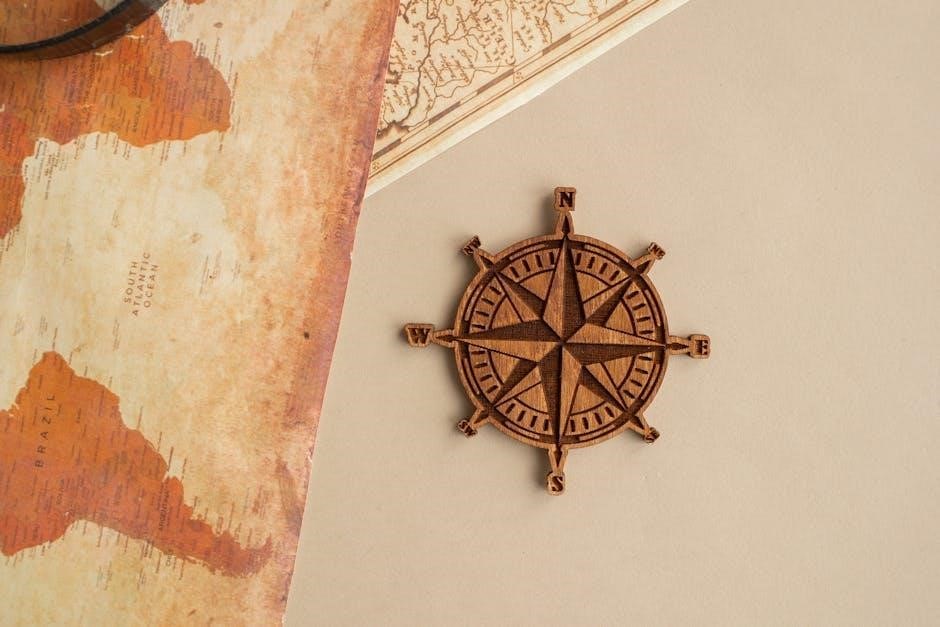A whetstone grit guide helps you understand the importance of grit levels in sharpening tools. Learn how different grits, from coarse to fine, shape and refine edges for optimal performance.
What is a Whetstone?
A whetstone is a sharpening tool used to hone and refine the edges of knives, blades, and other cutting tools. Typically made from materials like ceramic, stone, or synthetic compounds, it consists of abrasive particles that wear down the metal to create a sharper edge. The grit of the stone determines its abrasiveness, with lower grits being coarser and higher grits finer. Whetstones have been used for centuries and are favored by chefs, outdoor enthusiasts, and knife enthusiasts for their effectiveness in maintaining and restoring blade sharpness. By using a whetstone, one can remove metal, align the edge, and achieve a razor-sharp finish, making it an essential tool for anyone needing precise cutting performance. Regular maintenance, such as cleaning and flattening, ensures the stone remains effective for sharpening.
Importance of Grit in Whetstone Sharpening
Grit is a critical factor in whetstone sharpening, as it determines how aggressively the stone sharpens the blade. Lower grits, like 1000, are coarse and remove metal quickly, making them ideal for shaping or repairing damaged edges. Higher grits, such as 3000 or 6000, are finer and polish the edge, enhancing sharpness and reducing roughness. The right grit ensures efficient sharpening, preventing unnecessary wear on the blade. Without proper grit selection, sharpening can be ineffective or even damaging. Grit progression, from coarse to fine, is essential for achieving a razor-sharp edge and maintaining knife longevity. Understanding grit levels allows users to tailor their sharpening process to specific needs, whether restoring a dull blade or refining a precision edge for optimal performance.
Understanding Whetstone Grit
Whetstone grit refers to the size of abrasive particles on the stone’s surface, determining how aggressively it sharpens. Coarser grits remove metal faster, while finer grits polish edges.
What Does Grit Mean?
Grit refers to the size of the abrasive particles on a whetstone’s surface. It determines how aggressively or finely the stone sharpens a blade. Lower grit numbers, like 1000, indicate larger particles that remove metal quickly, ideal for repairing dull edges or shaping tools. Higher grit numbers, such as 6000, signify smaller particles that polish and refine the edge, creating a sharper, smoother finish. The grit level is crucial because it dictates the sharpening process’s speed, the amount of metal removed, and the final edge quality. Understanding grit is essential for selecting the right stone to achieve the desired sharpness for specific tasks, ensuring efficiency and precision in sharpening.
Coarse vs. Fine Grit: Key Differences
Coarse grit whetstones are designed for heavy-duty sharpening tasks, such as repairing damaged edges or shaping tools. They typically range from 1000 to 3000 grit and remove metal quickly, making them ideal for restoring dull blades. Fine grit whetstones, on the other hand, are used for polishing and refining edges, offering a smoother finish. These stones, often 6000 grit or higher, are perfect for final sharpening stages, creating a razor-sharp edge. The key difference lies in their purpose: coarse grit is for rough shaping, while fine grit is for precision and polish. Understanding this distinction helps users choose the right tool for their sharpening needs, ensuring optimal results.

Common Whetstone Grit Levels
Whetstone grit levels range from 1000 to 10000, with lower grits (1000-3000) for sharpening and higher grits (6000-10000) for polishing edges to a razor-sharp finish.
1000 Grit: For Basic Sharpening
The 1000 grit whetstone is a coarse grit ideal for basic sharpening tasks. It is typically used to restore dull edges or shape tools that require significant metal removal. This grit is excellent for setting a new bevel or repairing damaged blades. The coarse texture allows for aggressive sharpening, making it a great starting point for heavily worn or blunt knives. While it may not produce a polished edge, it lays the foundation for finer grits to refine. For beginners, the 1000 grit is a reliable choice for sharpening straight-edge knives or tools like axes and chisels. Always use water to keep the stone lubricated and clean to maintain effectiveness. Regular use of this grit ensures tools remain functional and sharp for everyday tasks.
3000 Grit: For Intermediate Sharpening
The 3000 grit whetstone is a medium-coarse grit designed for intermediate sharpening. It is finer than the 1000 grit, making it suitable for refining edges after initial shaping. This grit is excellent for polishing and maintaining knives that are already sharp but need a touch-up. It removes less metal than coarser grits, allowing for more precise edge refinement. The 3000 grit is ideal for everyday knives, culinary tools, or any blade requiring a sharp yet durable edge. It strikes a balance between sharpening and polishing, preparing the blade for finer grits if desired. Regular use of the 3000 grit ensures tools stay sharp and perform well for general tasks. Always use water to lubricate the stone and maintain its effectiveness during sharpening sessions.
6000 Grit: For Fine Sharpening
The 6000 grit whetstone is a fine-grit stone designed for advanced sharpening and polishing. It is used after coarser grits to refine and hone the edge of a blade to a razor-sharp finish. This grit is ideal for final touches, creating a mirror-like polish on the blade’s surface. The 6000 grit is perfect for high-quality knives, straight razors, or tools requiring extreme sharpness and precision. It removes minimal metal, focusing instead on aligning and smoothing the edge. For optimal results, use water to lubricate the stone and maintain consistent pressure. The 6000 grit is a must for achieving professional-level sharpness and is often used by experienced sharpeners for finishing touches. Regular use ensures blades remain sharp and perform exceptionally well for precise tasks.

Choosing the Right Grit for Your Needs
Selecting the appropriate grit depends on the tool’s condition, desired sharpness, and sharpening stage. Coarser grits are for repairing dull edges, while finer grits refine and polish. Always start coarse and progress to finer grits for optimal results. Match the grit to your tool’s needs for best performance.
When to Use Coarse Grit (1000-3000)
Coarse grit whetstones (1000-3000) are ideal for repairing and shaping dull or damaged edges. Use 1000 grit to restore a very dull knife or remove small nicks. For heavier repairs, such as sharpening axes or resetting bevels, start with 1000 or 2000 grit. These grits efficiently remove metal, making them perfect for initial sharpening or reprofiling tools. They are also great for maintaining working edges that require a balance of sharpness and durability. Coarse grits are not for polishing but for laying the foundation for finer sharpening. Always use coarse grits when the tool’s edge is severely worn or needs significant reshaping before moving to finer grits for refinement.

When to Use Fine Grit (6000 and Above)
Fine grit whetstones (6000 and above) are designed for polishing and refining edges to achieve a razor-sharp finish. Use 6000 grit to remove minor imperfections and create a keen edge. For higher precision, 8000 or 10000 grit stones are ideal for final honing, leaving a mirror-like finish. Fine grits are best for maintaining already sharp tools or knives, as they remove minimal metal. They are perfect for honing straight razors, high-carbon steel knives, or any tool requiring extreme sharpness. Avoid using fine grits for dull or damaged edges, as they are not aggressive enough to repair them. Instead, use them as the final step in your sharpening process to achieve optimal results and maintain edge retention.
Progressive Sharpening: Combining Grits
Progressive sharpening involves using a sequence of whetstone grits to achieve the best results. Start with a coarse grit to shape and remove metal, then transition to finer grits for polishing. This method ensures a smooth, even edge. Begin with 1000 grit to establish the edge, then move to 3000 to refine it, and finish with 6000 or higher for a polished finish. Each grit builds on the previous one, gradually improving sharpness. This approach prevents over-sharpening and ensures optimal edge retention. It’s ideal for maintaining tools and knives, as it balances efficiency and precision. By combining grits, you can tailor the sharpening process to the specific needs of your blade, achieving professional-quality results at home.

Using Grit Progression for Optimal Results

Grit progression enhances sharpening by gradually refining the edge. Start with coarse grits to shape the blade, then finer grits for polishing. This method ensures better edge quality and reduces metal removal, leading to a sharper, more durable tool. Proper progression prevents over-sharpening and maintains blade integrity. Always clean between grits to avoid contamination. This systematic approach is essential for achieving professional-level sharpness. Grit progression optimizes results for both beginners and experienced sharpeners, ensuring consistency and precision in every stroke.
Starting with Coarse Grit
Starting with coarse grit is essential for effective sharpening. Coarse grits, such as 1000, quickly remove metal, shaping the blade and establishing a sharp edge. They correct nicks, straighten edges, and set the foundation for finer sharpening. Using coarse grit first ensures faster progress and prevents over-sharpening. It’s crucial for restoring dull or damaged tools. Always begin with coarse grit to create the initial edge geometry before refining it with finer grits. This step is vital for achieving optimal results and maintaining tool longevity.
Switching to Fine Grit
Switching to fine grit is a critical step in the sharpening process, typically after using coarse grit. Fine grits, such as 6000 or 8000, refine the edge, removing minor imperfections and creating a polished finish. This step enhances sharpness and ensures a smooth cutting performance. When transitioning, maintain consistent angle and pressure to avoid uneven results. Fine grits are designed for final touches, not metal removal, so they should only be used after the edge is well-established. Regular use of fine grit extends tool longevity and improves overall functionality. Always clean the stone before switching grits to prevent contamination. Proper timing and technique ensure optimal results, making fine grit indispensable for achieving professional-grade sharpness.

Maintaining Your Whetstone
Regular maintenance ensures your whetstone remains effective. Clean the stone with water or oil, and flatten it periodically to maintain even surfaces and consistent sharpening results.
Cleaning the Whetstone
Cleaning your whetstone is essential to maintain its effectiveness and longevity. For water stones, rinse thoroughly under running water to remove metal particles and debris. For oil stones, use a cleaning oil or petroleum-based solvent to dissolve and wipe away residue. After cleaning, dry the stone with a clean cloth to prevent rust or damage. Regular cleaning prevents contamination and ensures consistent sharpening results. Avoid using harsh chemicals or abrasive cleaners, as they can damage the stone’s surface. Proper maintenance keeps your whetstone in optimal condition, ensuring sharp edges and precise sharpening every time. Regular care extends the life of your tool, making it a reliable asset for all your sharpening needs.
Flattening the Whetstone
Flattening a whetstone is essential to maintain its effectiveness and ensure even sharpening. Over time, the stone’s surface may become uneven due to wear, leading to inconsistent results. To flatten the stone, place it on a flat surface like glass or a cutting board. Use sandpaper, starting with a coarse grit to remove material quickly, then progressing to finer grits for polishing. Apply moderate pressure, ensuring not to crack the stone. Check the stone’s flatness by drawing pencil lines and observing uniform wear. After flattening, clean the stone thoroughly to remove debris. For deep scratches or chips, start with very coarse grit sandpaper. Regular checks and maintenance are crucial to keep the stone effective, ensuring consistent sharpening angles and performance.

Troubleshooting Common Issues
Identify and address issues like uneven sharpening, excessive metal removal, or a glazed stone. These problems often stem from improper grit progression or poor stone maintenance. Corrective steps vary based on the issue but may involve re-flattening the stone or adjusting sharpening technique. Regular inspection and proper care can prevent many of these challenges, ensuring consistent and effective sharpening results. Always refer to specific solutions for each problem to restore optimal performance.

Glazed or Polished Stones
A whetstone can become glazed or polished due to improper use or excessive sharpening without proper maintenance. This occurs when metal particles and abrasive residues fill the stone’s pores, creating a smooth, shiny surface. A glazed stone loses its sharpening efficiency, as the abrasive particles are no longer exposed. To fix this, clean the stone thoroughly with water or sharpening oil to remove residue. If the issue persists, flatten the stone using a dressing stone or coarse sandpaper to expose fresh, sharp grit. Regular cleaning and proper sharpening techniques can prevent glazing. Always inspect your stone before use and maintain it to ensure optimal sharpening performance. A well-cared-for whetstone will remain effective for years.
Uneven Wear on the Stone

Uneven wear on a whetstone occurs when certain areas of the stone become worn down more than others, creating an uneven surface. This can happen due to inconsistent sharpening techniques or applying too much pressure on specific spots. Over time, this unevenness can affect the stone’s ability to sharpen evenly. To address this, regularly flatten the stone using a dressing stone or coarse sandpaper. This process restores the stone’s surface to a flat, even state. Proper sharpening posture and consistent pressure can help prevent uneven wear. Always inspect the stone for wear patterns and maintain it regularly to ensure consistent sharpening results. A well-maintained whetstone will provide years of reliable service.
Excessive Metal Removal
Excessive metal removal during sharpening can lead to unnecessary wear on the tool and a less precise edge. This often occurs when using a coarse grit stone too aggressively or applying too much pressure. To avoid this, start with lighter pressure and gradually increase as needed. Using the correct grit for the task is essential; coarse grits (e.g., 1000) are for repairing damaged edges, while finer grits (e.g., 6000) are for polishing. If too much metal is removed, revert to a coarser grit to correct the edge before refining it. Regularly cleaning the stone and maintaining proper sharpening angles will also help minimize excessive metal loss. Balancing pressure and grit selection ensures efficient sharpening without over-reducing the tool.
Mastery of whetstone grit is essential for achieving sharp, precise edges on knives and tools. By understanding the differences between coarse and fine grits, you can tailor your sharpening process to suit specific needs. Always start with coarser grits for repairing damaged edges and progress to finer grits for polishing. Proper maintenance, such as cleaning and flattening the stone, ensures optimal performance. Troubleshooting issues like glazed stones or uneven wear can enhance your sharpening experience. Remember, sharpening is a skill that improves with practice. Patience and attention to detail will yield better results. With the right grit progression and consistent technique, you can unlock the full potential of your whetstone and achieve razor-sharp edges every time.
